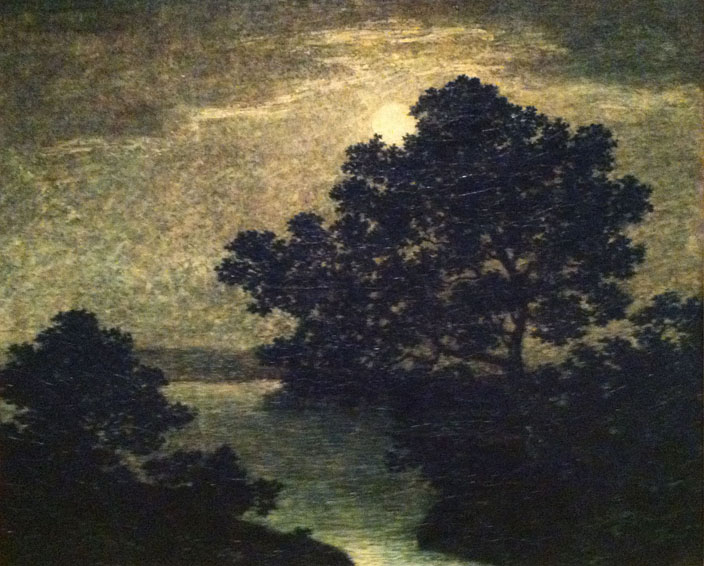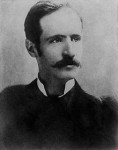
Ralph Albert Blakelock
American, 1847-1919
Lake by Moonlight, n.d.
oil on canvas
18 x 22 in.
SBMA, Bequest of Margaret Mallory
1998.50.14

Photo of Blakelock dated 1870.
"What if the clouds one short dark night, hide the blue sky until morn appears. When the bright sun that cheers soon again will rise to shine upon earth for endless years."
Ralph Blakelock
RESEARCH PAPER
Although hailed as a visionary artist by many scholars of American art, Ralph Albert Blakelock, a painter of romantic landscapes and Native American life in the 19th century, was virtually ignored by the public during his lifetime. He holds a questionable place in American art; admired by some, revered by a few, but forgotten by most. Surprisingly, during the last two decades of his life, until his death in 1919, Ralph Blakelock was perhaps the best-known living American artist. His paintings sold for previously unheard sums. In 1913 he sold a painting to a US senator for $13,900 and in 1916, Blakelock sold one for $20,000. His work became highly desirable and for a time his paintings represented the most commonly forged and imitated works by a living American painter. Works by his daughter, Marian, were also attributed to Blakelock as dealers attempting to cash in on Ralph’s fame would rub out her signature and replace it with her father’s. She was trained by him and painted in his style. The height of Blakelock’s popularity occurred between the time of his commitment to an insane asylum in 1899 and continued until his death. Subsequently his popularity waned, but during the last 25 to 30 years, renewed interest in 19th and 20th century American Paining has again focused attention on Ralph Albert Blakelock.
Concurrently, research on Blakelock was underway at the University of Nebraska Art Galleries. The Nebraska Blakelock Inventory was begun in 1968 and constituted an in-depth study of Blakelock, his work and style. This study has examined over 1500 of Blakelock’s paintings from public and private holdings. As of 1996, the study was still continuing. The inventory categorized these works in terms of their authenticity and ranked them in one of four groups. The groups ranged from consisting of works with completely documented histories of ownership and having technical and stylistic features by which to compare other works, to a group consisting of paintings without histories and whose physical and stylistic features do no agree in any way with those known to be representative of Blakelock. One finding of the study was the fact that many exhibitions and sales of Blakelock’s paintings have included questionable works. Also, while the paintings were being solicited by the university for review and examination, an unscrupulous individual posing as the director of the Nebraska Art Galleries went around the country attempting to collect these works for his own purpose.
"Lake by Moonlight" was given to the museum in 1998 following the death of Margaret Mallory, according to the terms of her bequest. It was included in the University of Nebraska study in 1969 while owned by Mallory. The painting was photographed in black and white, by infrared light, and with x-ray. Preliminary findings were released to Miss Mallory in 1971. These findings focused on the physical condition of the oil painting and revealed areas of retouching, areas of contraction crackle, and some repair. The Curatorial Department of the Santa Barbara Museum of Art is assured of its authenticity.
"Lake by Moonlight" is one in a series of paintings by Blakelock that have come to represent his signature works. These carry such names as "Moonlight," "Moonlight Sonata," "Moonlit Lake," and "Moonlight, Silver and Old Lace." The latter is also part of the Santa Barbara Museum of Art’s collection. The "moonlights" featured a combination of elements: trees, water, light (moon), air and night. Blakelock painted most of the paintings of this type between 1873 and his confinement for mental illness in 1898, although these landscapes are not dated. There are many "moonlights." They are definitely similar one to another, variations on a theme but of uneven quality. They share a common sense of mystery and drama and a deep sensitivity to nighttime. The best examples among them are uniquely and individually evocative. It should be noted here that Blakelock concurrently painted "sunsets" and "twilights."
"Lake by Moonlight" is a horizontal landscape painting that prominently features a tall tree rising to almost the full height of the painting from the right foreground. The shadowy silhouette of leaves, branches, and trunk are set against a misty background of sky. The dark leaves of this tree are lacy and overlap and frame the full moon that is shrouded in haze. Blakelock was fascinated with the growth process of plants, which is evidenced in the clearly delineated texture of branches, twigs, and leaves. There is a lower tree rising from the left foreground with other shrub-like foliage. The various plans, leaves, and ground areas are painted very dark colors, shades of the darkest green-black with a hint of blue. Muted light emanates from the background in the area of the moon that is painted a creamy pale-yellow. Light is reflected by water in the foreground and seems to luminesce through the clouds. The lake is seen only in part, cropped by the edge of painting. Blakelock’s use of chiaroscuro is amplified in the "moonlights" as compared to his earlier paintings. It has been said generally of his technique that Blakelock first prepared a sensually pleasing background and created on top of it, often without a clearly conceived outcome in mind. In this painting one can see a pale background peaking through much of the surface of the canvas. Broad, flat brushstroke can be barely seen in the upper left corner of the painting. Throughout much of Blakelock’s work and certainly in this painting, light and space are dominant elements. In "Lake by Moonlight," the high contrast between light and dark enhances the drama creating an almost worshipful mood. The exhibition catalog from the University of California Santa Barbara’s showing of Blakelock’s work referred to a "picturesque melancholy" in describing his paintings (1969).
Ralph Blakelock was a self-taught artist who primarily painted landscapes. Although his father planned for Ralph to study homeopathy like himself, this was not to be. From childhood Ralph showed a proclivity for art and music and spent countless hours drawing. He attended college briefly. He started off well but by his third semester his poor grades placed him eighty-second in a class of 116. His father financed a trip West and in 1869, Ralph Blakelock set off on a three-year journey through the Western United States, parts of Mexico, Central America, and the Caribbean. He sketched as he went, observing and drawing the vast landscapes and the indigenous people he encountered. While none of his paintings can be directly tied to a specific image, his sojourn into the wilderness helped to shape his perception of the land and arm him with hundreds of sketches and pages of notes from which to draw upon.
Blakelock’s early paintings were influenced by the Hudson River School and evidenced the same postcard perfection, the grandeur of the land, the stringent attention to detail, and of course, the Westward Movement. The observed subject rather than the artist’s personality is the principal focus here. Typical of accomplished self-taught artists, Blakelock acquired the technical skill equal to the standard of his day and at the beginning of his career, he can be loosely placed within the Hudson River School. During various stages, his works relate him to the Barbizon School with their limited palette, high-sky, and broad horizon, although Blakelock was less interested in portraying the fidelity of his subjects. His has also been called a "visionary" painter, a form of American art that bypasses realism. As his work evolved it became more unique and personal. He experimented with glazing techniques, rubbing his works with pumice stones and layers of paint. His materials were usually of poor quality due to the high cost of good materials.
Blakelock married in 1875 his wife, Cora Baily, was 18. (Her family started the Barnum and Baily’s Circus bringing the first elephant across the Atlantic to Texas). They had nine children, including one daughter who died in infancy. Ralph painted to support his growing family and was known to have painted below his standard to take care of them. Cora explained the uneven quality of her husband’s work in a letter to an art dealer by informing him that his best work took a very long time to complete and in the mean time, the family had to live. Mental illness further accounted for the variations in the quality of Blakelock’s work. His mental illness caused him to direct his frustration against himself, and he had been known to literally burn up cash proceeds from the sale of his works when he felt they were brought at too low a price. He was diagnosed with schizophrenia and spent many years in the hospital.
While institutionalized he painted, and the prices for his works escalated along with his fame. While institutionalized, a Mrs. Adams, who won the confidence of his doctors but exploited Ralph and his family, befriended Blakelock. She established The Blakelock Fund, which she drained for her own benefit. She held guardianship of Blakelock, managed his affairs and took title to his works. She was cruel and physically abusive, as well as a formidable foe to Mrs. Blakelock who was unsuccessful in taking her on. The Blakelock heirs believe that Ralph’s "accidental" death in her custody was a result of one of her beatings. In an interesting twist of fate that Mrs. Adams herself was later hospitalized in the same hospital as her former charge and never released.
Blakelock was unaware of the public recognition that surrounded him late in his life. Unable to attend his funeral, President Woodrow Wilson regretted having been unable to pay his respects to his memory in person. The recognition and great sums of money paid for his art benefited dealers but not the artist. He was impoverished, barely able to support his family throughout his career.
BibliographyBooks:
1. Davidson, Abraham A. Ralph Albert Blakelock.
The Pennsylvania State University Press, 1996
Exhibition and Sales Catalogues (arranged chronologically):
1. The Enigma of Ralph A Blakelock, 1847-1919.
An exhibition organized by David Gebhard and Phyllis Stuurman
for the Art Galleries, University of California, Santa Barbara (January 7-February 2, 1969). "Blakelock –Biographical Notes" by Phyllis Stuurman; "The Art of Ralph A. Blakelock" by David Gebhard. Santa Barbara, 1969
2. M. Knoedler & Co., Inc. Ralph Albert Blakelock 1849 (sic) –1919,
March 3-March 31, 1973. Text by Jack Tanzer, Warren J. Adelson, David D. Blackelock, and Susielies M. Blakelock. New York, 1973.
3. Sheldon Memorial Art Gallery. Ralph Abert Blakelock 1847-1919
(January 14-February 9, 1975). Text by Norman A. Geske. Lincoln
Nebraska, 1975Santa Barbara Museum of Art Curatorial Files:
1. Correspondence between the University of Neraska and Margaret Mallory, 1971
Prepared for the Santa Barbara Museum of Art Docent Council by:
Garilynn Stanfield
April 11, 1999
